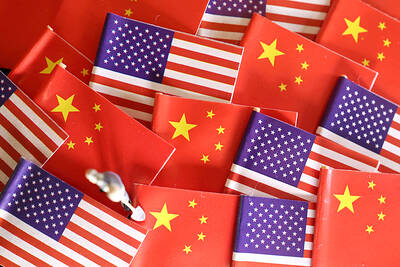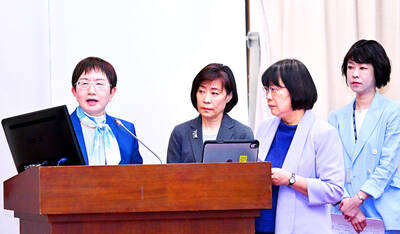The bar is buzzing on a busy night at Chicago Cut steakhouse as regulars Keith and Peg Bragg sit at a high table scanning the wine list.
Within seconds, they have all bottles under US$40 at their fingertips using an iPad supplied by their server.
“You can very quickly look through to see the price per bottle,” said Keith, a finance executive, as he scrolled through rows of selections. “You can read the wine tasting note, how long it has been aged.”
The upscale eatery on the northern bank of the Chicago River has invested in 40 iPads at about US$700 each for wine selection. Since April, when Apple debuted the tablet, the device is now in use as a full menu at upscale restaurants, hamburger eateries and quick-service chains like Au Bon Pain. Restaurateurs said that’s just the beginning.
Chicago Cut partnered with a technology firm to create a custom app that looks like a virtual wine cellar. It lists the restaurant’s more than 750 wines, includes photos of bottles on wooden shelves and allows for searches based on variety, price or region of origin.
Diners can also access information about a wine’s taste, composition and a Google map of the vineyard.
“Eventually the bottle is going to spin around and you can read the back label,” Chicago Cut managing partner Matt Moore said. In the future, programmers could add video or let customers e-mail themselves the name of a new favorite wine.
Moore’s partner, David Flom, said the iPads were a large investment, but they’re already showing returns.
“I’ve already seen an increase of wine per customer of 20 percent,” Flom said. “I can’t say that the iPad commanded 100 percent, but I can say it commanded a significant portion of that.”
Technology is becoming increasingly important to restaurants and tabletop ordering devices only stand to multiply, said Darren Tristano, executive vice president at the Chicago-based restaurant consulting firm Technomic.
“It’s cool and trendy and kids love it,” he said. “It paves the way for other opportunities with applications.”
Au Bon Pain uses iPads at six of its 220 locations, with plans to expand. Ed Frechette, the company’s vice president of marketing in Boston, said diners usually fill out pieces of paper with their orders at the cafes, but iPads have simplified the process.
“One of our employees has an iPad with a menu loaded in it and they’ll take your order,” Frechette said. “You still see a menu board with all the information on it. We have handheld laminated menus for a reference, but all the paper pads are gone.”
At 4Food in New York, where diners can build and name their own burgers, iPads are at eight kiosks with plans for as many as 30 devices, including Android and Blackberry platforms. Customers order and enter credit card information into the iPad to pay. Managing partner Adam Kidron said ordering food electronically will eventually be the norm.
“You’ve just got to imagine that this is something that won’t just be considered to be a discretionary behavior,” Kidron said. “It will be a necessary behavior.”
Restaurants do face a few challenges. Tristano points out that restaurant owners must consider how to keep the tablets juiced up.
At Chicago Cut, Flom said the iPads are loaded with tracking software to prevent theft. And there are customers who won’t want to use iPads.
Jay Clark, who headed the team at Shared Marketing Services Inc that created Chicago Cut’s iPad program, said while he sees unlimited uses for the digital devices in restaurants, paper menus need to be available, too.
“If people are very tactile and they’re comfortable with a paper menu, they should be able to have it,” he said. “People have to be comfortable with technology.”

‘SWASTICAR’: Tesla CEO Elon Musk’s close association with Donald Trump has prompted opponents to brand him a ‘Nazi’ and resulted in a dramatic drop in sales Demonstrators descended on Tesla Inc dealerships across the US, and in Europe and Canada on Saturday to protest company chief Elon Musk, who has amassed extraordinary power as a top adviser to US President Donald Trump. Waving signs with messages such as “Musk is stealing our money” and “Reclaim our country,” the protests largely took place peacefully following fiery episodes of vandalism on Tesla vehicles, dealerships and other facilities in recent weeks that US officials have denounced as terrorism. Hundreds rallied on Saturday outside the Tesla dealership in Manhattan. Some blasted Musk, the world’s richest man, while others demanded the shuttering of his

ADVERSARIES: The new list includes 11 entities in China and one in Taiwan, which is a local branch of Chinese cloud computing firm Inspur Group The US added dozens of entities to a trade blacklist on Tuesday, the US Department of Commerce said, in part to disrupt Beijing’s artificial intelligence (AI) and advanced computing capabilities. The action affects 80 entities from countries including China, the United Arab Emirates and Iran, with the commerce department citing their “activities contrary to US national security and foreign policy.” Those added to the “entity list” are restricted from obtaining US items and technologies without government authorization. “We will not allow adversaries to exploit American technology to bolster their own militaries and threaten American lives,” US Secretary of Commerce Howard Lutnick said. The entities

Minister of Finance Chuang Tsui-yun (莊翠雲) yesterday told lawmakers that she “would not speculate,” but a “response plan” has been prepared in case Taiwan is targeted by US President Donald Trump’s reciprocal tariffs, which are to be announced on Wednesday next week. The Trump administration, including US Secretary of the Treasury Scott Bessent, has said that much of the proposed reciprocal tariffs would focus on the 15 countries that have the highest trade surpluses with the US. Bessent has referred to those countries as the “dirty 15,” but has not named them. Last year, Taiwan’s US$73.9 billion trade surplus with the US

Prices of gasoline and diesel products at domestic gas stations are to fall NT$0.2 and NT$0.1 per liter respectively this week, even though international crude oil prices rose last week, CPC Corp, Taiwan (台灣中油) and Formosa Petrochemical Corp (台塑石化) said yesterday. International crude oil prices continued rising last week, as the US Energy Information Administration reported a larger-than-expected drop in US commercial crude oil inventories, CPC said in a statement. Based on the company’s floating oil price formula, the cost of crude oil rose 2.38 percent last week from a week earlier, it said. News that US President Donald Trump plans a “secondary